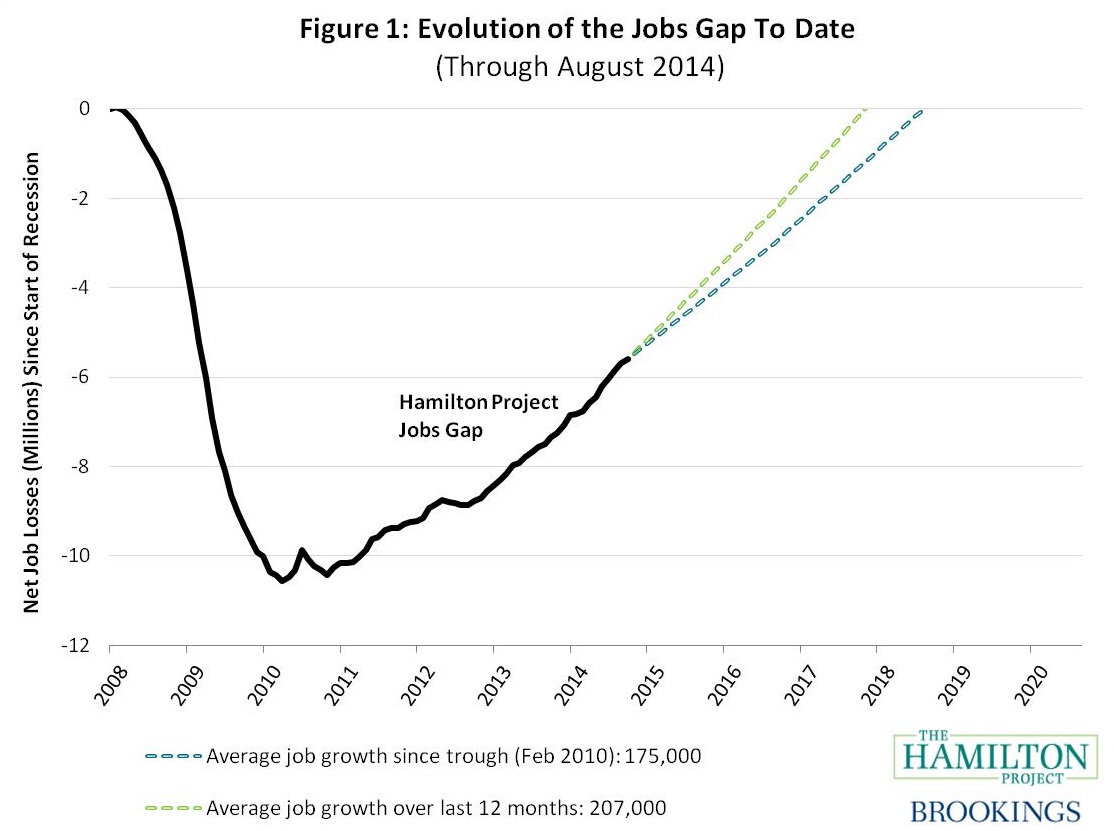Employers added 142,000 jobs in August, according to today’s employment report from the Bureau of Labor Statistics. This rate of job creation represents a slowdown from that of previous months, and is the first time the economy gained fewer than 200,000 jobs over the month since January of this year. Although the unemployment rate has steadily declined since 2011, reaching 6.1 percent last month, the broader measure of the employment-to-population ratio, which includes people who have stopped looking for work, has changed little since the end of the Great Recession. It currently stands at 59.0 percent, up less than 1 percentage point over the last five years, and far less than its pre-recession level of 62.7 percent in late 2007.
Each month, The Hamilton Project calculates America’s “jobs gap,” or the number of jobs that the U.S. economy needs to create in order to return to pre-recession employment levels while absorbing the people who newly enter the labor force each month. As of the end of August 2014, our nation faces a jobs gap of 5.6 million jobs.

If the economy continues to add 175,000 jobs per month, the average rate since the jobs recovery began in March 2010, it will take until July 2018 to close the jobs gap. Under the slightly more optimistic rate of 207,000 jobs per month, the average rate of job growth over the preceding 12 months, the jobs gap will close in October 2017.
This picture of a steady—if prolonged—labor market recovery masks stark differences between the private and public sectors. The private sector has now seen 54 straight months of payroll gains totaling 10.0 million jobs; the public sector has actually lost more than half a million jobs over the same period. In an August 2012 analysis, The Hamilton Project discussed the decline in public-sector employment, noting that the share of the population in government jobs was at a 40-year low.
The divergence in public- and private-sector job gains can be seen by constructing The Hamilton Project jobs gap separately for the public and private sectors. The private-sector jobs gap, as shown in Figure 2, is 4.0 million. If this sector continues to add jobs at the average rate since the recovery began in March 2010, the private-sector jobs gap will close in January 2017—18 months earlier than the overall jobs gap. Using the faster recovery rate of the last 12 months, the gap will close even sooner, in October 2016.

The public sector, on the other hand, has a current jobs gap of 1.6 million. Unlike the private sector, government jobs have not recovered at all (Figure 3). At best, the public-sector gap has stopped growing over the last few months. Interestingly, the public-sector jobs gap emerged much later than the private-sector jobs gap; whereas private-sector job losses began in early 2008, the public-sector gap appeared only in the summer of 2009.[1] Put differently, the public-sector job loss began to accelerate only after the private sector had already begun to recover. These divergent trajectories are due to fundamental differences in the drivers of employment across the two sectors, and The Hamilton Project plans to investigate their causes and consequences in future analyses.

In sum, the stagnation in public-sector employment has dragged down the labor market recovery. If public-sector employment had remained constant as a share of the population, the total jobs gap would be roughly 28 percent smaller.
(To explore the total jobs gap further, including outcomes under alternative job creation scenarios, visit the interactive jobs gap calculator.)
[1] Public-sector job losses were temporarily reversed in the spring of 2010 by the hiring of short-term workers for the 2010 Census, represented by the spike in the figure.
The Brookings Institution is committed to quality, independence, and impact.
We are supported by a diverse array of funders. In line with our values and policies, each Brookings publication represents the sole views of its author(s).



Commentary
A Tale of Two Jobs Gaps: Private-Sector Recovery and Public-Sector Stagnation
September 5, 2014